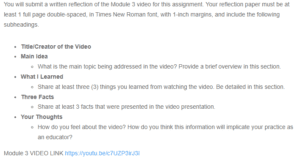Reading Wars Phonics Versus Whole Word
The title of the module 3 video is “Reading Wars Phonics Versus Whole Word,” created by Jared Cooney Horvath. Its main idea is how best one should teach kids how to read. The video explains different techniques, such as teaching kids letter-sound combinations and how letter sounds can be combined to make words that teachers would use to promote good reading skills.
Three things were learned from the video: first, teachers should focus on teaching kids to read holistically and not worry about the letters and sounds by concentrating wholly on words and utilizing context to recognize each word. The second lesson is that decomposing words into sounds and letters is a powerful strategy for teaching kids reading. Finally, I learned that the brain is adaptable, and with little training, it can process lines and squiggles as letters and as meaningful and complete objects.
The video also presents three facts: first, the brain holistically recognizes the visual imaging process. Secondly, the area where the teacher focuses their attention dictates how the kids learn reading skills, identify materials, and progress further in learning. For instance, the teacher should focus on holistic reading and stop worrying about letters and sounds. Finally, the brain is divided into two, the right and left. The right side of the back of the brain ensures visual processing of daily objects, whereas the left side of the back of the brain breaks words into small chunks and assigns sound to these chunks. Skilled readers use the left side of the back of the brain, while illiterate people use the right side of the back of the brain (Horvath, 2020).
The video is very educative and informative. It offers great insights that would be handy for future and already practicing educators. From the information gathered in the video, as a tutor, I would practically implement the strategies Horvath (2020) highlights to nurture kids reading skills and acknowledge where I should focus most attention. For instance, while teaching kids reading, I should focus on holistic reading rather than letters and sounds.
References
Horvath, J, C. (2020). Reading Wars | Phonics vs. Whole Word [Video].
ORDER A PLAGIARISM-FREE PAPER HERE
We’ll write everything from scratch
Question 
You will submit a written reflection of the Module 3 video for this assignment. Your reflection paper must be at least 1 full page double-spaced, in Times New Roman font, with 1-inch margins, and include the following subheadings.

Reading Wars Phonics Versus Whole Word
- Title/Creator of the Video
- Main Idea
- What is the main topic being addressed in the video? Provide a brief overview in this section.
- What I Learned
- Share at least three (3) things you learned from watching the video. Be detailed in this section.
- Three Facts
- Share at least 3 facts that were presented in the video presentation.
- Your Thoughts
- How do you feel about the video? How do you think this information will implicate your practice as an educator?
Module 3 VIDEO LINK https://youtu.be/c7UZP3irJ3I
